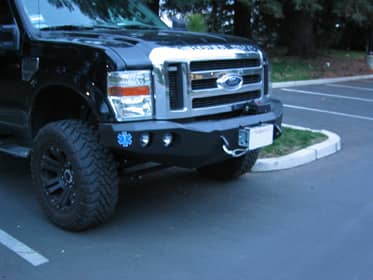Have you ever wondered if swapping that stock bumper on your truck for a new Road Armor bumper would cause any issues to your airbags? Or, if there are certain bumpers that are better for airbag deployment? Aftermarket bumpers may look great and have additional features, but do they promote your safety in the end?

Finally, let’s ask—do aftermarket bumpers affect airbags? Since airbags deploy due to a certain amount of force that hits the vehicle, aftermarket bumpers may have a small effect on when and how an airbag deploys. Manufacturers have designed and tested their stock bumpers to work specifically with their vehicle’s safety systems.
Stock bumpers tend to absorb more energy because they are not as rigid as most aftermarket bumpers. This means that with an aftermarket bumper, the force may be greater and can cause the airbag to deploy faster than with a stock bumper. But, this depends on the type of aftermarket bumper chosen and how the force was applied to the vehicle.
Common Aftermarket Bumpers and Their Airbag Deployment
Aftermarket bumpers are created with different gauges of steel. When the gauge is lower, the steel is thicker and more rigid. Though the steel may be thicker, it is not always best for airbag deployment. This is because the more rigid the steel is, the less likely it is to absorb force caused by impact. In theory, the more rigid a bumper is can cause an airbag to deploy sooner. This is because less energy is being absorbed by the aftermarket bumper than the stock bumper.
Remember: An aftermarket bumper includes any bumper that was not originally included on the vehicle and a stock bumper was the bumper originally tested and designed for the vehicle.
There are many different aftermarket bumpers available for many different brands of trucks. The table below includes popular aftermarket bumpers, their gauge of steel, and compatible truck brands.
| Bumper Name | Material | Compatible Trucks |
| Steelcraft Elevation Front | 6 Gauge Steel | Chevrolet, Ford, Ram, Toyota, GMC |
| Ranch Hand Sport | 3/16” Steel (comparable to 7 Gauge Steel) | Chevrolet, Ford, Ram, Toyota, GMC |
| Road Armor Front Stealth | 7 Gauge Steel | Chevrolet, Ford, Ram, Jeep, Toyota |
| Go Rhino BR5.5 | 7 Gauge Steel | Chevrolet, Ford, Ram, GMC |
| ADD Race Series | 7 Gauge Steel | Ford |
| Iron Cross | 10 Gauge Steel | Chevrolet, Ford, Ram, Toyota, GMC |
| Ranch Hand Summit | 12 Gauge Steel | Chevrolet, Ford, Ram, Jeep, Toyota |
Note: Not all aftermarket bumpers may be compatible with every truck model.
Quality Check!
So, are some bumpers better than others for airbag deployment? Aftermarket bumpers have a very minimal effect on airbag sensors. The biggest change will be the thickness of the bumper which may cause the sensor to react faster and deploy the airbag sooner.
The other difference between stock bumpers and aftermarket bumpers is that the manufacturer designed and tested the stock bumper. With being crash tested, the stock bumper was modified to allow the airbags to deploy at the right time. This does not mean that aftermarket bumpers are more dangerous, nor does it mean they are safer.
Cosmetic changes, like the bumper, typically don’t alter the safety specifications. Think about cars that don’t have bumpers; the airbag would still go off regardless of the bumper being there or not. Airbag sensors are not located in the bumper but usually behind the bumper and other common impact locations on the vehicle.
Choosing an aftermarket bumper that has a similar gauge as the stock bumper is an option to replacing the stock bumper with very minimal changes to the airbag deployment. Again, changes will depend on the make and model of the vehicle. Since different vehicles have a variety of bumper dimensions and locations of their airbag sensors, not every aftermarket bumper may be an option for every vehicle.
Size Matters
In this case, the thickness of your aftermarket bumper matters. All bumpers are not made equally and will have different specifications to fit the use of the bumper. The gauge of steel is used to determine how thick the metal of the bumper is. Aftermarket bumpers have different thicknesses because they have a variety of uses.
Thicker bumpers are created to assist in heavy-duty work and will usually be constructed using a mixture of 1/4” and 3/16” steel. If you are not planning on using your bumper for heavy-duty work, then the most average thickness lies around 3/16”.
Below is a conversion chart showing the most common gauges of steel and how thick they are in inches.
| Gauge | Inches |
| 3 | 1/4” |
| 6 | 13/64” |
| 7 | 3/16” |
| 8 | 11/64” |
| 9 | 5/32” |
| 10 | 9/64” |
| 11 | 1/8” |
| 12 | 7/64” |
Reminder: The lower the gauge is, the thicker the steel will be.
How Do Airbags Normally Deploy?
Airbags are created with three main components:
- Bag- A thin, nylon fabric, which is folded in the steering wheel, dashboard, and depending on the vehicle, they may also be added in the doors or seats.
- Sensor- Also depending on the vehicle, airbag sensors have been placed in common collision areas. The sensor tells the bag to inflate when there is a certain amount of force, around 8-14 mph, that comes in contact with the vehicle.
- Inflation System- As the final piece of the airbag system, inflation happens due to sodium azide reacting with potassium nitrate to create nitrogen gas.
When a crash happens, the sensor will be the first contact. The sensors will then send an electric signal to the inflation system which will cause the potassium nitrate, or the igniter compound, to explode. The heat from the explosion reacts with the sodium azide, turning it into its nitrogen gas form. The nitrogen gas then fills the airbag within a matter of milliseconds.
After an accident, the airbag quickly deflates because the nitrogen gas quickly disperses through tiny holes in the airbag. Airbags are most commonly located in the steering wheel and dashboard of most vehicles. Newer vehicles now have airbags located in the seat and/or near the door to help with side collisions.
This video is a visual explanation of how airbags work:
Airbags were created to react quickly to help reduce possible injuries that a passenger can experience during a crash. Basically, airbags act as a cushion between the head and chest of the passenger and the hard surfaces (steering wheels, dashboards, etc.) of the car.
The main benefits that airbags provide include:
- Adding cushion to the head, neck, and spine during a crash
- Limiting the area that the head can fling forward
- Airbags absorb more of the force from the collision, so the victim doesn’t have to
- Decreases the chances of a person going through the windshield or being flung out of the car
There are several options if you want to know where your airbags are located. You can contact the dealer and ask them where the airbags are on you make and model or you can find the locations in the car that say airbag. The airbag is usually kept behind a small piece of plastic that will have “airbag” engraved into it.
Pros and Cons of Aftermarket Bumpers
Now that you fully understand both how bumpers are made and how airbags work, let’s discuss the advantages and disadvantages of each.
Aftermarket Bumper Pros:
- Have little to no effect on airbag deployment
- Allow for additional customization options
- Can include extra options, such as, tow bars and grills
- Come in different sizes to meet different needs
Aftermarket Bumper Cons:
- Have not been crash tested like the stock bumper
- May cause airbag to deploy sooner
- Don’t absorb as much force as stock bumpers
Let’s Sum it Up
To conclude, aftermarket bumpers have very little effect on airbags and should not compromise the safety of your vehicle. Airbags do not rely on bumpers to deploy, but on the sensor that is usually located behind the bumper and in other common crash areas.
If you’re thinking of different ways to accessorize your truck or make it more functional, consider checking out my recommended accessories page. I spent a good amount of time picking out mods that can be useful for most pickup trucks.

